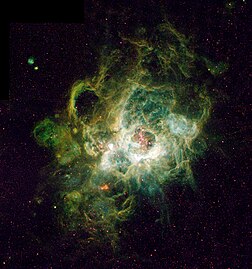
Back H II-gebied Afrikaans منطقة هيدروجين II Arabic Rexón H II AST Вобласць H II Byelorussian एच टू इलाका Bihari H II অঞ্চল Bengali/Bangla H II područje BS Regió H II Catalan Oblast HII Czech H-II-Gebiet German

An H II region or HII region is a region of interstellar atomic hydrogen that is ionized.[1] It is typically in a molecular cloud of partially ionized gas in which star formation has recently taken place, with a size ranging from one to hundreds of light years, and density from a few to about a million particles per cubic centimetre. The Orion Nebula, now known to be an H II region, was observed in 1610 by Nicolas-Claude Fabri de Peiresc by telescope, the first such object discovered.
The regions may be of any shape because the distribution of the stars and gas inside them is irregular. The short-lived blue stars created in these regions emit copious amounts of ultraviolet light that ionize the surrounding gas. H II regions—sometimes several hundred light-years across—are often associated with giant molecular clouds. They often appear clumpy and filamentary, sometimes showing intricate shapes such as the Horsehead Nebula. H II regions may give birth to thousands of stars over a period of several million years. In the end, supernova explosions and strong stellar winds from the most massive stars in the resulting star cluster disperse the gases of the H II region, leaving a cluster of stars which have formed.
H II regions can be observed at considerable distances in the universe, and the study of extragalactic H II regions is important in determining the distances and chemical composition of galaxies. Spiral and irregular galaxies contain many H II regions, while elliptical galaxies are almost devoid of them. In spiral galaxies, including our Milky Way, H II regions are concentrated in the spiral arms, while in irregular galaxies they are distributed chaotically. Some galaxies contain huge H II regions, which may contain tens of thousands of stars. Examples include the 30 Doradus region in the Large Magellanic Cloud and NGC 604 in the Triangulum Galaxy.
- ^ Ian Ridpath (2012). A Dictionary of Astronomy: H II region (2nd rev. ed.). Oxford University Press. doi:10.1093/acref/9780199609055.001.0001. ISBN 9780199609055. Retrieved 24 December 2015.